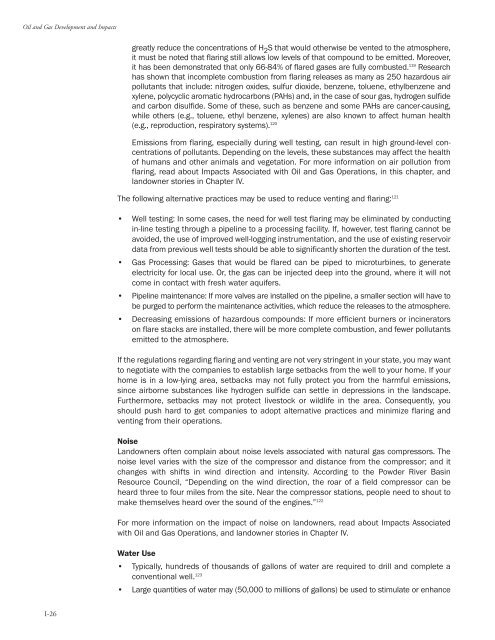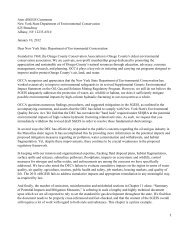Oil and Gas at Your Door? (2005 Edition) - Earthworks
Oil and Gas at Your Door? (2005 Edition) - Earthworks
Oil and Gas at Your Door? (2005 Edition) - Earthworks
You also want an ePaper? Increase the reach of your titles
YUMPU automatically turns print PDFs into web optimized ePapers that Google loves.
<strong>Oil</strong> <strong>and</strong> <strong>Gas</strong> Development <strong>and</strong> Impacts<br />
gre<strong>at</strong>ly reduce the concentr<strong>at</strong>ions of H 2 S th<strong>at</strong> would otherwise be vented to the <strong>at</strong>mosphere,<br />
it must be noted th<strong>at</strong> flaring still allows low levels of th<strong>at</strong> compound to be emitted. Moreover,<br />
it has been demonstr<strong>at</strong>ed th<strong>at</strong> only 66-84% of flared gases are fully combusted. 119 Research<br />
has shown th<strong>at</strong> incomplete combustion from flaring releases as many as 250 hazardous air<br />
pollutants th<strong>at</strong> include: nitrogen oxides, sulfur dioxide, benzene, toluene, ethylbenzene <strong>and</strong><br />
xylene, polycyclic arom<strong>at</strong>ic hydrocarbons (PAHs) <strong>and</strong>, in the case of sour gas, hydrogen sulfide<br />
<strong>and</strong> carbon disulfide. Some of these, such as benzene <strong>and</strong> some PAHs are cancer-causing,<br />
while others (e.g., toluene, ethyl benzene, xylenes) are also known to affect human health<br />
(e.g., reproduction, respir<strong>at</strong>ory systems). 120<br />
Emissions from flaring, especially during well testing, can result in high ground-level concentr<strong>at</strong>ions<br />
of pollutants. Depending on the levels, these substances may affect the health<br />
of humans <strong>and</strong> other animals <strong>and</strong> veget<strong>at</strong>ion. For more inform<strong>at</strong>ion on air pollution from<br />
flaring, read about Impacts Associ<strong>at</strong>ed with <strong>Oil</strong> <strong>and</strong> <strong>Gas</strong> Oper<strong>at</strong>ions, in this chapter, <strong>and</strong><br />
l<strong>and</strong>owner stories in Chapter IV.<br />
The following altern<strong>at</strong>ive practices may be used to reduce venting <strong>and</strong> flaring: 121<br />
• Well testing: In some cases, the need for well test flaring may be elimin<strong>at</strong>ed by conducting<br />
in-line testing through a pipeline to a processing facility. If, however, test flaring cannot be<br />
avoided, the use of improved well-logging instrument<strong>at</strong>ion, <strong>and</strong> the use of existing reservoir<br />
d<strong>at</strong>a from previous well tests should be able to significantly shorten the dur<strong>at</strong>ion of the test.<br />
• <strong>Gas</strong> Processing: <strong>Gas</strong>es th<strong>at</strong> would be flared can be piped to microturbines, to gener<strong>at</strong>e<br />
electricity for local use. Or, the gas can be injected deep into the ground, where it will not<br />
come in contact with fresh w<strong>at</strong>er aquifers.<br />
• Pipeline maintenance: If more valves are installed on the pipeline, a smaller section will have to<br />
be purged to perform the maintenance activities, which reduce the releases to the <strong>at</strong>mosphere.<br />
• Decreasing emissions of hazardous compounds: If more efficient burners or inciner<strong>at</strong>ors<br />
on flare stacks are installed, there will be more complete combustion, <strong>and</strong> fewer pollutants<br />
emitted to the <strong>at</strong>mosphere.<br />
If the regul<strong>at</strong>ions regarding flaring <strong>and</strong> venting are not very stringent in your st<strong>at</strong>e, you may want<br />
to negoti<strong>at</strong>e with the companies to establish large setbacks from the well to your home. If your<br />
home is in a low-lying area, setbacks may not fully protect you from the harmful emissions,<br />
since airborne substances like hydrogen sulfide can settle in depressions in the l<strong>and</strong>scape.<br />
Furthermore, setbacks may not protect livestock or wildlife in the area. Consequently, you<br />
should push hard to get companies to adopt altern<strong>at</strong>ive practices <strong>and</strong> minimize flaring <strong>and</strong><br />
venting from their oper<strong>at</strong>ions.<br />
Noise<br />
L<strong>and</strong>owners often complain about noise levels associ<strong>at</strong>ed with n<strong>at</strong>ural gas compressors. The<br />
noise level varies with the size of the compressor <strong>and</strong> distance from the compressor; <strong>and</strong> it<br />
changes with shifts in wind direction <strong>and</strong> intensity. According to the Powder River Basin<br />
Resource Council, “Depending on the wind direction, the roar of a field compressor can be<br />
heard three to four miles from the site. Near the compressor st<strong>at</strong>ions, people need to shout to<br />
make themselves heard over the sound of the engines.” 122<br />
For more inform<strong>at</strong>ion on the impact of noise on l<strong>and</strong>owners, read about Impacts Associ<strong>at</strong>ed<br />
with <strong>Oil</strong> <strong>and</strong> <strong>Gas</strong> Oper<strong>at</strong>ions, <strong>and</strong> l<strong>and</strong>owner stories in Chapter IV.<br />
W<strong>at</strong>er Use<br />
• Typically, hundreds of thous<strong>and</strong>s of gallons of w<strong>at</strong>er are required to drill <strong>and</strong> complete a<br />
conventional well. 123<br />
• Large quantities of w<strong>at</strong>er may (50,000 to millions of gallons) be used to stimul<strong>at</strong>e or enhance<br />
I-26




